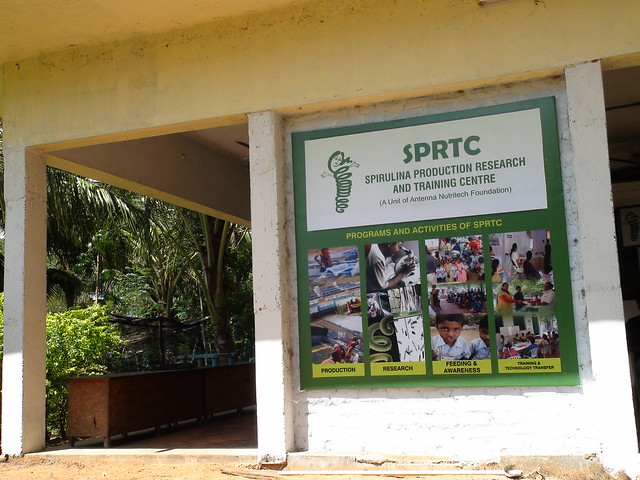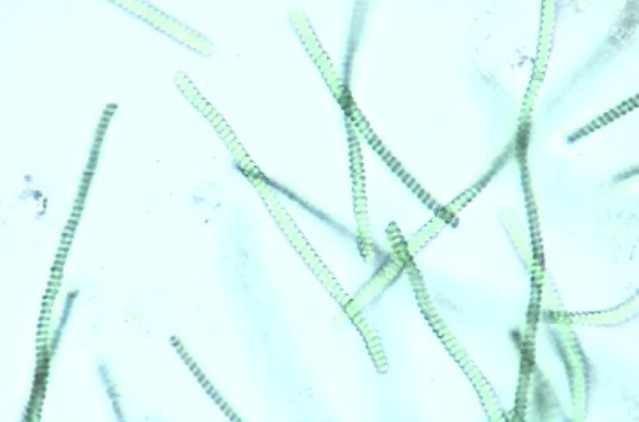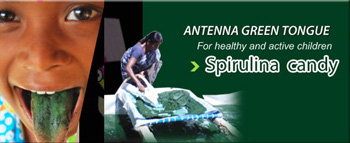Meet Super Spirulina
I met Spirulina for the first time in the southern part of India. Anne-Gaëlle took me for a visit to a branch of Antenna Technologies in Madurai (Tamil Nadu).
Antenna Technologies is an NGO (Non Governmental Organization). This organization undertakes and promotes the research and the development of simple, sustainable and low-cost technologies that meet the needs of the poorest populations, thus enabling them to improve their own living conditions. These actions concern access to drinking water, a diversified diet, an electricity grid or medicines. The work is carried out in collaboration with an international network of scientists. Here in Tamil Nadu, Antenna Technologies has set up a Spirulina production and research center, the Spirulina Production Research and Training Center (SPRTC).

The Spirulina
I have the impression of entering a park where the grass plots are replaced by ponds with an intense green color. These are spirulina culture basins, and spirulina is a microscopic algae.

I meet Arthi. She is in charge of the Spirulina production and explains that Spirulina is a tool that serves to fight against malnutrition! Before telling me more, she makes me discover the place.
The SPRTC plays a social role for the emancipation of women: after training, women from the surrounding villages are employed in the production of spirulina. Cultivation, mixing, harvesting - they tell me about their way of working.

After filtering the green suspension from the water in these ponds, one of the women stretches a pasty material for me to see. I’m apprehensive, asking, ‘Really, do you eat this?’
Arthi explains that Spirulina can be converted to a variety of different forms after drying : as flakes, powder, candy among others.
In candy?! Yes, in this center, the flagship product is a spirulina candy distributed to children from 2 to 7 years of age in order to prevent deficiencies and to fight against malnutrition.
A microalga against malnutrition? This sounds incredible. It is time to get a little more into the heart of the matter.
Spirulina - is it an alga or bacterium?
The term spirulina refers to several species belonging to the genera1 Spirulina or Arthrospira2. Here in Madurai, the cultivated species is an Indian variety: Arthrospira platensis var lonar3.
Spirulina is a blue-green alga. Is it somehow related to the smurf algae Anne-Gaëlle mentioned earlier? I also hear about cyanobacteria. I need to clarify something: this spirulina, is it an alga or a bacterium?
Well done Jacqueline! Given the smiles that my question arouses, I think I have asked a smart question!
Arti takes me to the laboratory and and points me to look into the microscope. I discover a magnificent spectacle: under my eyes, fluorescent green spiral filaments wiggle and turn themselves! This green liquid contains these pretty spirals, what a pity they can not see them with the naked eye. What a pity that we can not see them with the naked eye. These planktonic4 elements hide such an artistic surprise!

These little living things, microorganisms, contain a molecule called chlorophyll. This is what adds the greenish hue and is part of the reason why this form of life can perform photosynthesis. They grow in water, either fresh, marine or brackish. This is why initially the spirulina was considered an alga.
But then, in the early 1960s, the international scientific community adopted a classification of living and fossil organisms that distinguished between prokaryotes and eukaryotes: basically, the difference between the two can be summarized by “the eucaryote cell is super complex compared to the prokaryote cell!”(if you want to know a bit more, check the footnote 55!). Analysis were done. They led to the discovery of facts. They proved - without alternative - that spirulina has the properties of prokaryotes. As for algae, they are eucaryotes!
In the prokaryotes, spirulina belong to a particular microorganisms group called cyanobacteria. If you want to know more where does that name come from, check out the footnote 66.
Spirulina is therefore a bacterium with some plant-like behavior. If I understand correctly, scientifically Spirulina is a bacterium, commercially it is counted as a microalga! Come on, call it by name and it will be simpler: Spirulina is a cyanobacterium. Well what interests me now is to know more about the nutritional properties of this “super-food”.
Competing for the title of the most complete food on Earth
Spirulina has outstanding nutritional qualities. Even though it has a very high amount of protein (between 55 and 70% of its dry weight), its key nutritional fact lies in the diversity of essential fatty acids, amino acids, Vitamins, trace elements, minerals, enzymes, coenzymes, etc. (FAO, 2008, Vidalo, 2008). Spirulina could easily be one of the most complete foods on the Earth’s surface!
I have learned that this food is known and traditionally used for millennia in certain parts of the world. In the 16th century, when the Spanish arrived in Central America, they discovered that the Aztecs harvested a green mud called “tecuitlatl” from green lakes and made it into small blue cakes. According to some legends, spirulina was an important source of food for marathon runners of the time!
In Africa, Kanembu people harvest spirulina on the shores of Lake Chad. After drying in the sun, they make spirulina patties (called “dihe”), used in the kitchen or eaten directly in nearly 70% of their meals.
Super Spirulina fights malnutrition
But back to our ponds in India! Arthi explains that this is the micronutrients content of spirulina that is so precious to fight deficiencies: one gram of spirulina would provide a micronutrients intake equivalent to that contributed by the consumption of one kilogram of assorted fruits and vegetables.
For almost 20 years, the SPRTC has distributed spirulina in the form of candies to more than 20,000 children aged 2 to 7 years. Children receive one gram of spirulina for a up to a year. The distribution takes place via their school, or with self-help groups or volunteers. This one gram of spirulina completely covers the micronutrients needs of children7. And in addition, the treats make the green tongue! Funny and good for health, it’s the sweet dream for big and small!

Arthi talks about the power of spirulina and its potential to address widespread deficiencies around the world such as deficiencies in Iron or Vitamin A.
Iron can be absorbed by the human body only when it is associated with a combination of Vitamins. These are often destroyed or damaged by cooking food. Since spirulina is consumed without treatment and without cooking, the Iron of spirulina is thus well absorbed by the human body.
A common concern with vitamin A deficiency is that supplements to correct it may lead to overdose and side effects. This is not a problem with Spirulina, as it contains beta-carotenes, a precursor of Vitamin A (provitamin A). This form is assimilated by the body without any risk of an overdose. Further, any surplus provitamin A will be converted into compounds which further improve health! (eg antioxidant compounds).
Spirulina is also a very high-productivity plant. But like any crop, the quality of the spirulina produced depends on the mode of production. Our health depends on the health of the environment in which we grow our food. It works the same way for spirulina too!
Spirulina has more superpowers!
In France, until recently, spirulina was mostly known as tablets or capsules. These are taken as a dietary supplement. Lately, more and more spirulina farms have been settling all over the country. It will grow soon on the roofs, like it is the case in Bangkok in Thailand8!
The products and recipes to add spirulina to our menus grow and we can soon cultivate this spirulina at home in a ‘phytotière’, a spirulina maker9 designed by George Garcia!
We have come across spirulina several times during our trip, in laboratories around the world and in the fields run by various companies. Crop systems are varied, from large-scale production pits with paddle wheels to the most advanced photobioreactors for feed or biotechnology applications.
It seems that spirulina still holds many other surprises: at the CSMCRI in India, for example, Dr. Mishra showed me her work on bioplastics and bioremediation of heavy metals using spirulina. We will come back on these complex words very soon!
Among others innovations! On my return to Brittany, I was surprised to find spirulina in a pig farm! Spirulina was grown commercially there, valuing the CO2 and the heat emitted by the methanization unit of the farm! Spirulina would not have finished surprising us and we will have the opportunity to talk about it again.
Spirulina is not the only group of blue-green algae we encountered on the road. We saw some that had neither the appearance nor the color of the spirulina … they looked like pebbles - the stromatoliths! See you soon in the Stromatoliths chapter! Exploration continues!
Learn more
Some bibliography and links for going further:
-
Vidalo, J-L. 2008. Spiruline. L’algue bleue de santé et de prévention. Editions du Dauphin.(in French)
-
Habib, M.A.B, Parvin, M., Huntington, T.C. and Hasan, M.R. 2008. A review on culture, production and use of spirulina as food for humans and feeds for domestic animals and fish. FAO Fisheries and Aquaculture circular. No. 1034.
-
Henrikson, R. 2009. Earth Food Spirulina: How This Remarkable Blue–Green Algae Can Transform Your Health and Our Planet. Ronore Enterprises. Inc., Hana.
-
A film from 1989 made by Dr. Ripley D. Fox about integrated cultivation systems in Togo.
Footnotes:
-
A genus (plural: genera) is a rank in the biological classification of living and fossil organisms. A genus groups several species sharing similar characteristics (genus on Wikipedia). ↩
-
Arthrospira platensis and A. maxima are the most widely represented species of spirulina. (FAO, 2008) ↩
-
Arthrospira platensis var lonar was found in the Lake Lonar, a meteoritic crater lake in India. (Fox, R. D. 1996. Spirulina: Production & Potential. Edisud). Fascinating, isn’t it?! ↩
-
In the cells of the eucaryotes, the DNA is contained in a nucleus and the various specialized structures of the cell (called organelles) are delimited by a membrane (a phospholipid one to be precise!). In prokaryotes cells, there is no nuclei and no organelles membranes. ↩
-
Cyanobacteria: this name comes from the fact that these microorganisms possess a blue pigment in a high proportion: phycocyanin (phyco-: algae, cyan: blue). They also have a red pigment, phycoerythrin. Under certain conditions, these pigments may mask the green color of the chlorophyll. ↩
-
Each spirulina candy brings the equivalent of 0.5 g of spirulina and represents an intake of 12.6 kcal (Protein: 0.21 g, carbohydrate: 2.95 g, lipid: trace, iron: 0, 15mg, β-carotene: 1.3mg) (source Antenna Nutritech Foundation) ↩
-
Urban farming in Bangkok: growing Spirulina on rooftops ↩
-
Discover the phytotière and the association La Voie Bleue ↩